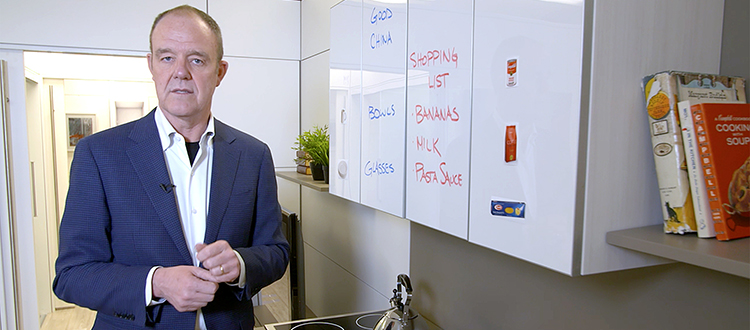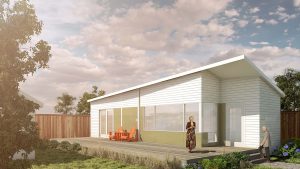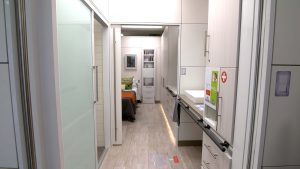
June 06, 2016 | Alex Frazer Harrison
Time and a place
Seniors' groups welcome potential option to aging in placeSeniors' advocates in Calgary are cautiously praising a city council decision to look at a University of Calgary pilot project that's studying laneway housing as an option to aging in place.
In mid-May, council agreed to support a motion by Coun. Gian-Carlo Cara that would have City administration work with the university as it embarks on the next phase of its Aging-In-Place Laneway Housing project.
Kerby Centre CEO Luanne Whitmarsh called the idea, "a really interesting concept," but added more study needs to be done, such as ensuring that, "it isn't just going to make more isolation.
"Also, what does it look like? If (seniors) still need support and there are people entering the home instead of a grassy front yard, it's a back alley. We have to look at quality of life," she said.
"I love the idea of 'dropping' it into the yard."
The pilot involves a functional prototype of a prefabricated and portable 460-square-foot home with one bedroom and one bathroom, as well as living and dining areas.
"The whole idea is it's something that is used only for the time someone is living in it, and then it can be picked up and relocated," said John Brown, associate dean of research with the University of Calgary's Faculty of Environmental Design, which is collaborating with Cumming School of Medicine, O'Brien Institute for Public Health and Alberta Real Estate Foundation on the project.
"We've been looking at innovative solutions for aging in place."
The prototype unit at the university includes hook-ups to accommodate needs such as oxygen and chronic disease therapies, should seniors' health needs evolve.
 Photo courtesy University of Calgary.
Photo courtesy University of Calgary."It's been carefully designed so, as a person's physical or medical needs increase, all those elements can be seamlessly added to it without causing a disruption," says Brown.
Calgary Seniors' Resource Society executive director Lori Paine liked the project's modular concept as a solution to seniors living in isolation.
It provides "a great opportunity for families to stay together and for seniors to have some independence and support in the community," she said. "It's not just aging in place, but aging in the right place.
... I could see this if they're modular and created so that they're going to be supportive of the seniors if they need additional assistance. And if (the seniors) move into a home later, that modular can be taken out and go someplace else."
Whitmarsh, meanwhile, welcomed the idea of professionals from multiple disciplines coming together to examine options for seniors housing. According to the City, the number of Calgarians over the age of 65 will increase from 120,216 in 2014 to 166,000 in 2024 and 226,000 in 2034. The City says the population over the age of 65 will become the fastest-growing age group, with a growth rate that is twice as high as the total population.
"I think people have to arm themselves with information and opportunity to research all their options (for housing), and make the plan from there," said Whitmarsh.
Brown said it's too early to say when the modular homes may start turning up in communities, noting there is still a six-month test of the standalone prototype in one yet-to-be-determined location to come, followed by another six-month test in another community, during which factors like community impact will be examined.
The City of Calgary has already embarked on a three-year strategy to develop a more "age-friendly" city in light of some estimates that have the local senior population nearly doubling within the next decade.
 Photo courtesy University of Calgary.
Photo courtesy University of Calgary.Dubbed the Seniors Age-Friendly Strategy and released in 2015, the plan calls for the creation of community networks focused on issues such as housing, transportation and mobility.
Proposed actions include increasing the standard for provincially funded affordable housing from 10 to 15 per cent, advocating for sustainable provincial funding for the development of new affordable housing and introducing a land-use bylaw amendment to allow for more secondary suites.
Housing, in fact, represents just one of six age-friendly priorities identified by the City. Over the next three years, the City also plans to work on increasing access to information and services, improving community support and health infrastructure, as well as increasing the level engagement through better participation and inclusion.
The plan also calls for better responses to curb elder abuse, and improvements to transportation and mobility challenges.
The City's strategy underlines growing concerns as to whether municipalities such as Calgary are properly prepared to handle growing senior populations. A recent Federation of Canadian Municipalities (FCM) report predicted the number of seniors in the country will hit 10.4 million by 2036, double the level seen in 2011. The most rapid increase was in the 85-plus category.
Titled Seniors and Housing: The Challenge Ahead, the FCM report states Canada's seniors are facing "a perfect storm," with rent at seniors' residences reportedly costing 2.5 times the national average and nearly 700,000 senior households facing an affordability challenge.
"This report should be a wake-up call to any federal party that is serious about strengthening the economy," said FCM president Raymond Louie in the report. "It presents striking evidence that the crisis in housing is real and it's growing. Municipalities are working on solutions to protect Canadian families but we need a federal partner to join us."
 Photo courtesy University of Calgary.
Photo courtesy University of Calgary.In its 2015 Ageing in Place report, the Organisation for Economic Co-operation and Development (OECD) used Calgary as one of nine case studies along with cities such as Toyama, Japan and Helsinki, Finland.
In it, the OECD pointed to affordable housing as a vital part to aging in Calgary, yet noted the city has not done enough to bridge the gap between supply and demand. It said eligibility for affordable housing has historically hovered around 18 per cent, yet current supply is only around 2.5 per cent.
"As Calgary's population continues to increase, the demand for affordable housing will continue to grow and the gap in the housing system is likely to widen," said the OECD.
The global organization did, however, recognize the City's current Community Affordable Housing Strategy, which is focusing on providing affordable housing to households earning less than 65 per cent of the median income that spend more than 30 per cent of housing, regardless of their demographic.
Tagged: Affordable Housing | aging in place | backyard suites | boomers | Calgary Real Estate | Calgary Real Estate News | Gian-Carlo Carra | household income | laneway housing | seniors | Uncategorized | University of Calgary | YYCRE




